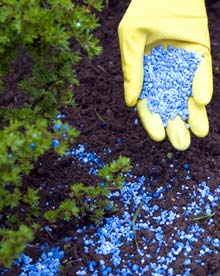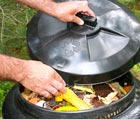- Gardening Tips |
- | What's NEW! |
- | Contact Us |
- | Sitemap
Fertilizing Your Garden
Fertilizing your garden is an excellent way to supplement nutrients that occur naturally in your garden soil.
Even if your garden starts off with the most perfect soil possible, over the years your flowers and plants will use up soil nutrients and these enrichening materials can help compensate for the loss.
There are three major nutrients that all plants require in order to develop and grow well:
- Nitrogen - develops the plant's green color in the foliage and stems; it's also the one nutrient that is most quickly used up by flowers and plants
- Phosphorus - promotes root growth and helps in developing flower and seed production
- Potassium - aids in the general health, durability, and disease resistance of flowers and plants
You'll notice the labeling on the packages refer to N-P-K. The proportions of N (nitrogen), P (phosphorus), and K (potassium) are listed by three numbers, such as 5-10-5 or 14-14-14. The ratios may differ for specific categories of plants such as roses, evergreens, or vegetables.
CAUTION! - Always follow package directions.
 Fertilizing
Fertilizing
These nutrient replacing materials are also available in two types. Synthetics are coated nutrients that slow down the rate of release when in contact with soil moisture.
Natural or organic products are ones where the release occurs by the activity of microorganisms living in the soil and converting the nutrients into forms the plant roots are able to absorb.
Although the granular (slow-release) formula is more expensive, it is easier to use in your garden beds. You only need to apply it once when you apply the whole season's worth at the beginning of the season.
It also stops dissolving in the summer when you don't want to be adding fertilizer and taking a chance on burning your flowers or plants anyway.
Liquid Garden Fertilizer and Foliar Sprays
You may want to consider applying a foliar spray. Foliar spraying allows your flowers and plants to take up and absorb nutrients more quickly through their leaves than through the soil.
You can do foliar spraying as often as every two weeks or if you'd prefer, two or three times each season will also prove beneficial. Spray plant foliage when the temperatures are below 80°F (26°C).
Using a foliar spray and going over your garden areas with two to three applications of a very diluted liquid seaweed fertilizer (seaweed/kelp emulsion) will provide more and brighter blooms with lusher foliage.
It will also improve the overall vigor and health of your flowers and plants by increasing their capacity to withstand drought and reduce the incidence of disease.
If you choose to use a foliar spray, you'll need a device that can produce a mist-like spray. A watering can, or a hand or pump sprayer could work.
A hose-end sprayer is proably the best and most efficient way to foliar-feed a larger garden area. Sprayers are available from garden supply centers, on-line, or in garden catalogs.
When using a packaged material not specific for foliar spraying, mix at half the strength listed on the package label. Be sure to mix or stir thouroughly before applying.
For any container plants in your garden areas, you'll want to use a water-soluble fertilizer instead of the granular, slow-acting type.
Fertilizing is the true source of soil nourishment and the use of special enrichening products can help improve or restore the balance to a deficiency or lack of nutrients in your soil.
Related Information:
Garden Care
To Top of this Fertilizing page
Return to Gardening Tips Home Page
Gardening Updates
Note: We'd love you to send us your favorite garden pics to feature on our new pages!
Contact Us and we'll send you an email address that can accommodate your photographs.

